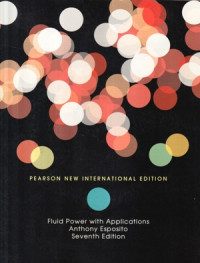Text
Fluid power with applications
Fluid power is called hydraulics when the fluid is a liquid and is called pneumatics when the fluid is a gas. Thus fluid power is the general term used for both hydraulics and pneumatics. Hydraulic systems use liquids such as petroleum oils, synthetic oils, and water. The first hydraulic fluid to be used was water because it is readily available. However, water has many deficiencies in comparison to hydraulic oils. For example water freezes more readily, is not as good a lubricant, and tends to rust metal compo¬nents. In spite of these deficiencies, there is a renewed effort underway to return to water in certain applications because of water's abundance, nonflammability, and envi¬ronmental cleanliness. When water hydraulics is used, the water contains additives to improve lubricity and rust protection and prevent freezing where necessary. Hydraulic oils are currently much more widely used than water, but as environmental concerns continue to become more serious, water hydraulics is expected to become more preva¬lent. Section 12.17 discusses the applications where water hydraulics should be used rather than oil hydraulics and the positive impact this would have on the environ¬ment. Pneumatic systems use air as the gas medium because air is very abundant and can be readily exhausted into the atmosphere after completing its assigned task.
There are actually two different types of fluid systems: fluid transport and fluid power.
Fluid transport systems have as their sole objective the delivery of a fluid from one location to another to accomplish some useful purpose. Examples include pump¬ing stations for pumping water to homes, cross-country gas lines, and systems where chemical processing takes place as various fluids are brought together.
Fluid power systems are designed specifically to perform work. The work is accomplished by a pressurized fluid bearing directly on an operating fluid cylinder or fluid motor. A fluid cylinder produces a force resulting in linear motion, whereas a fluid motor produces a torque resulting in rotary motion. Thus in a fluid power sys¬tem, cylinders and motors (which are also called actuators), provide the muscle to do the desired work. Of course, control components such as valves are needed to ensure that the work is done smoothly, accurately, efficiently, and safely.
Ketersediaan
Informasi Detail
- Judul Seri
-
-
- No. Panggil
-
532 Esp f
- Penerbit
- London : Pearson., 2014
- Deskripsi Fisik
-
iv, 648 hal. : il. ; 28 cm.
- Bahasa
-
Indonesia
- ISBN/ISSN
-
9781292023878
- Klasifikasi
-
532
- Tipe Isi
-
-
- Tipe Media
-
-
- Tipe Pembawa
-
-
- Edisi
-
Ed. VII
- Subjek
- Info Detail Spesifik
-
-
- Pernyataan Tanggungjawab
-
-
Versi lain/terkait
Tidak tersedia versi lain
Lampiran Berkas
Komentar
Anda harus masuk sebelum memberikan komentar

 Karya Umum
Karya Umum  Filsafat
Filsafat  Agama
Agama  Ilmu-ilmu Sosial
Ilmu-ilmu Sosial  Bahasa
Bahasa  Ilmu-ilmu Murni
Ilmu-ilmu Murni  Ilmu-ilmu Terapan
Ilmu-ilmu Terapan  Kesenian, Hiburan, dan Olahraga
Kesenian, Hiburan, dan Olahraga  Kesusastraan
Kesusastraan  Geografi dan Sejarah
Geografi dan Sejarah  Akuntansi
Akuntansi  Penelitian
Penelitian  Teknik Sipil
Teknik Sipil  Teknik Mesin
Teknik Mesin